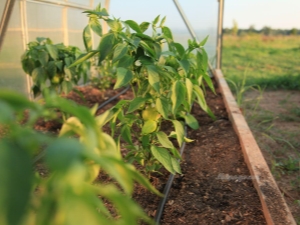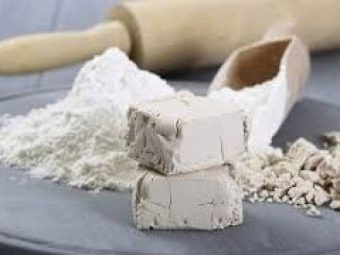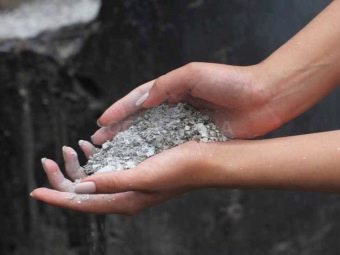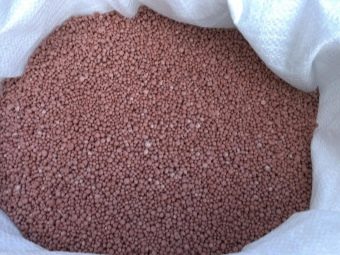Feeding peppers in the greenhouse: when and what fertilizers to use?

In the northern regions of Russia, it is quite difficult to obtain a high yield of sweet peppers if it is not fed with anything.Like all southern plants, sweet pepper is sensitive to the quality of the soil and the presence of useful elements in it. There is a huge number of different compositions, which of them is better to apply, at what time - this question is better studied thoroughly.
Timing
To plant pepper in the greenhouse it is recommended to prepare the soil for planting. The optimal composition is prepared based on this “recipe”:
- A tablespoon of superphosphate.
- A teaspoon of potassium sulfate.
- 5 kg of humus.
You can apply universal dressing, approximately a couple of large spoons per square meter of soil. After treatment with fertilizers, the soil is watered, the water should be above the temperature of +20 degrees. The site is covered with PVC film, aged for three days. After the soil is prepared, they plant the pepper.
Pepper needs after planting in the feed in the early morning before sunrise or in the evening. In the hot time, in the middle of the day, it is better not to water the plants and refrain from adding feedings. Fertilizing spend three or four for the entire period of growth of pepper.
After the planting of sweet pepper is completed (after ten days), additional feeding is made with the content of superphosphate and potassium salt. For ten liters of water you need to take two teaspoons of the components. For each bush, on average, spent on one liter of the composition.
It is important to remember: the solution should not fall on the leaves, the risk of damage is great.
The second dressing is done before the appearance of flowers:
- Potash salt (enough teaspoon).
- Superphosphate two tablespoons.
- A bucket of water.
Two weeks later, fertilizer is carried out with the following composition:
- Urea - 1 tbsp. spoon.
- Korovyak - one liter jar.
- Chicken dung 220 gr.
A sufficient amount of nitrogen makes it possible to fully develop the culture, promotes normal metabolism. Phosphorus is also important, especially for young plants, it contributes to the full formation of the fruit. Potassium is urgently needed when the fruit is sticking, this component is actively involved in the development of the fetus. Another important element is calcium, without it there can be no normal growth of plants.
It is important to fertilize at the right time and in the recommended amounts. If everything is done correctly, the high yield will not take long.
Facilities
If sweet pepper bushes do not grow well in a polycarbonate greenhouse, then additional fertilizing must be made, without them it is impossible to achieve normal growth and development of the culture.
To use iodine solution is, therefore, to increase yields. It is permissible to add iodine in reasonable quantities in any period of pepper development, this element is vital for a plant:
- When the plant blooms.
- When fruits.
Processing culture with iodine is also an effective tool that protects against parasites. Seedlings are watered with iodine solution (two drops are dissolved in 10 liters of water). Seeds can also be wetted with iodine solution. One drop dissolves in a liter of liquid, the seeds are soaked for six hours in this composition.
Pepper is a fastidious vegetable; it requires special attention from the gardener. Compliance with the correct processing, watering, fertilization - these are the components without which it is impossible to collect excellent harvest.
Additives of ash and yeast are widely popular, they are very effective means. Thanks to these compositions, the resistance of the plant is increased, metabolic processes are improved.
After treatment with similar compounds, pepper without any difficulties can withstand pruning. It is important to feed properly, observing the rules. An excess of useful components can lead to a negative result.
The technology of fertilizer preparation is simple; even a primary school student will prepare them. In the absence of yeast, they can be compensated for with moldy or stale bread.
Yeast is usually sold in bags of 10 grams., One such bag is enough for 10 liters.A bag of yeast is poured into a container (5-10 liters), the composition is settled for two or three days, a solution is made from it (1:10).
The use of ash is permissible in any variants for a variety of soils. A pair of tablespoons is added to two liters of liquid; the mixture is infused (24 hours), then it is poured under the pepper root. Often, the ashes just poured next to the stem of the plant. The foliar system is very sensitive, so solutions should not fall on it, it can cause a burn.
Purchased drugs
Pepper loves heat, in many northern regions of Russia they learned to grow peppers in greenhouses, feeding them with fertilizers. Different formulations are selected based on the following criteria:
- Variety of pepper.
- The time of year.
Mineral compositions that are recommended for pepper:
- "Crystal".
- "GUUMI Kuznetsova".
Make such formulations need to be timely, then there will be a rich harvest. To increase the yield of pepper, universal mixtures are often used; it is easier to work with them, although they are sometimes expensive. These include:
- "Ideal".
- Kemira Lux.
- "Aquadon-micro".
- "Orton."
All these substances have the necessary elements that contribute to the full development of plants.
Folk methods
There are folk remedies, for example, nettle infusion. In March, the peppers in the greenhouse are in dire need of mineral composition. Wood ash is an effective folk remedy that positively affects growth.
In order to avoid a disease called “black leg”, it is better to process the culture with green tea infusion. (One cup of tea is enough for 3 liters of water). Urea is diluted in water. It is necessary for pepper, it is an effective source of nitrogen.
Recommendations
Of the popular recipes to call in the first place you can banana peel, it insists, for three days, in the solution there is a large amount of potassium.
A composition made from yeast with milk is popular among summer residents: add a glass of milk to five liters of water, put two spoons of sugar, and a stick of yeast. The mixture is settled for 4 hours at a temperature of +20 degrees, then several buckets of water are added to it, the substance is thoroughly stirred. Plants are processed at the rate of: one bush accounts for one liter of composition. Gardeners often use yeast interspersed with weeds. Cooking method:
- Bucket of grass.
- 200 grams of yeast.
- Moldy bread loaf.
- Water 10 liters.
All contents are poured into a large container (40–70 liters) filled with warm water. At room temperature, the composition will "fit" for three days.
The people are very popular fertilizers that are made from manure and yeast with the addition of chicken manure. In one barrel (30-50 liters) mix:
- Wood ash (500 gr.).
- Sugar (75 gr.).
- Yeast no more than 150-200 grams is added.
The composition is infused for two to three days. On one pepper bush enough 1.2 liters of substance, it is very important to observe the correct concentration.
How to make?
Pepper grows only in the soil, where there are useful elements, in the "empty" earth the plant can not develop. That is why the topic is so relevant: timely feeding with the necessary microelements. Fertilize should be correct and on time, then good yields are guaranteed. It is very important to observe the required amount of the applied compositions in order not to harm the plant.
For pepper, you should make an average of four supplements for the entire period. The initial feeding is done during the picking period of the seedlings into separate small containers (no more than three leaves). In the period of the appearance of the first flowers, if the plant looks unimportant, it is faded and dries out, one more feeding is needed.
If the pepper has ripened, before harvesting it is necessary to make the following supplement of useful elements.
After transplant
Pepper must be fed complex mineral compounds. Universal fertilizers made with their own hands, including ash, yeast, are also suitable.
During the formation of ovaries
As soon as the first inflorescences appeared, it is recommended to make a top dressing, add a solution, consisting of components:
- Yeast-10 grams.
- Ash-100 grams.
- Water 10-12 liters.
Next to each bush is recommended to pour one liter jar of the composition. Repeat the procedure recommended in two weeks. Most often, this amount of fertilizer is enough for the plant to develop well.
In this period of time, additional trace elements are required:
- Magnesium.
- Sulfur.
- Cobalt.
- Molybdenum.
Much depends on the state of the soil, if the plant lacks something, then it "signals" about it with its appearance. Experienced farmers catch these signs and take action.
During flowering and fruiting
In this period of time should be carried out the most effective feeding with domestic bird droppings. Organics need to be diluted in water so as not to harm the plant.
During the flowering period, which usually occurs 14 days after planting, pepper requires various trace elements. To feed the culture using organics:
- Bird droppings, diluted and infused (1: 5).
- Ash (concentration 2%).
- Manure is diluted in a ratio of 1:10.
- Gardeners use traditional Nitroammofosku or Azofosku.
When flowering occurs, the soil is fertilized with carbamide (30 g. Per ten liters of water).
To make the fruit juicy and tasty, you should use:
- Superphosphate (20%).
- Potassium salt.
- Organic (mixed with water 1: 2).
Recommendations
To ensure the development and growth of pepper, crushed eggshells are put into the ground. She is poured into a three-liter jar of water, infused for four days. It is possible to process with a similar composition both saplings, and adult plants. For the preparation of nutritious mixes for pepper plants are used:
- Plantain.
- Sagebrush.
- Quinoa.
The compositions are prepared in a ratio of 1: 5. It is recommended to carry out all feeding work in the absence of sunlight, at an early time or with the onset of evening twilight.
It is necessary to acquire fertilizers only from reliable suppliers. The choice of top dressing should be done taking into account the general condition of the plant, which can have small fruits, leaves curl. This indicates a lack of nutrients.
Deficiency and oversupply are equally detrimental to pepper.
If the fruits are covered with brown markings, then this is confirmed by a calcium deficiency. Yellowing foliage indicates its excess. If there is no flowering, then there is too much nitrogen in the soil.
The lack of phosphorus leads to an increase in the ripening time of pepper. Drying foliage proves the absence of the required amount of potassium, it is clearly not enough. Sluggish and crumbling leaves indicate a lack of magnesium. Timely dressing of pepper will be a guarantee of high yield.
You can learn more about fertilizing peppers in the greenhouse in the next video.























































